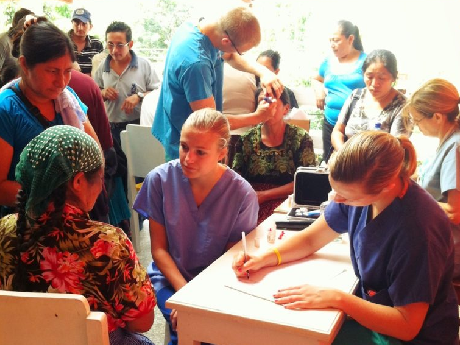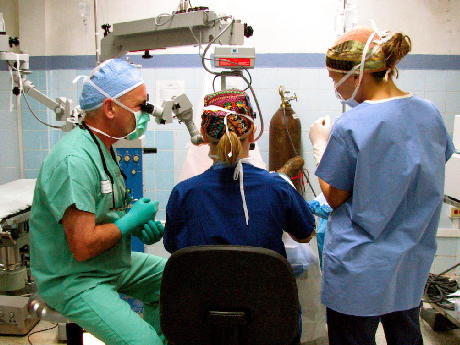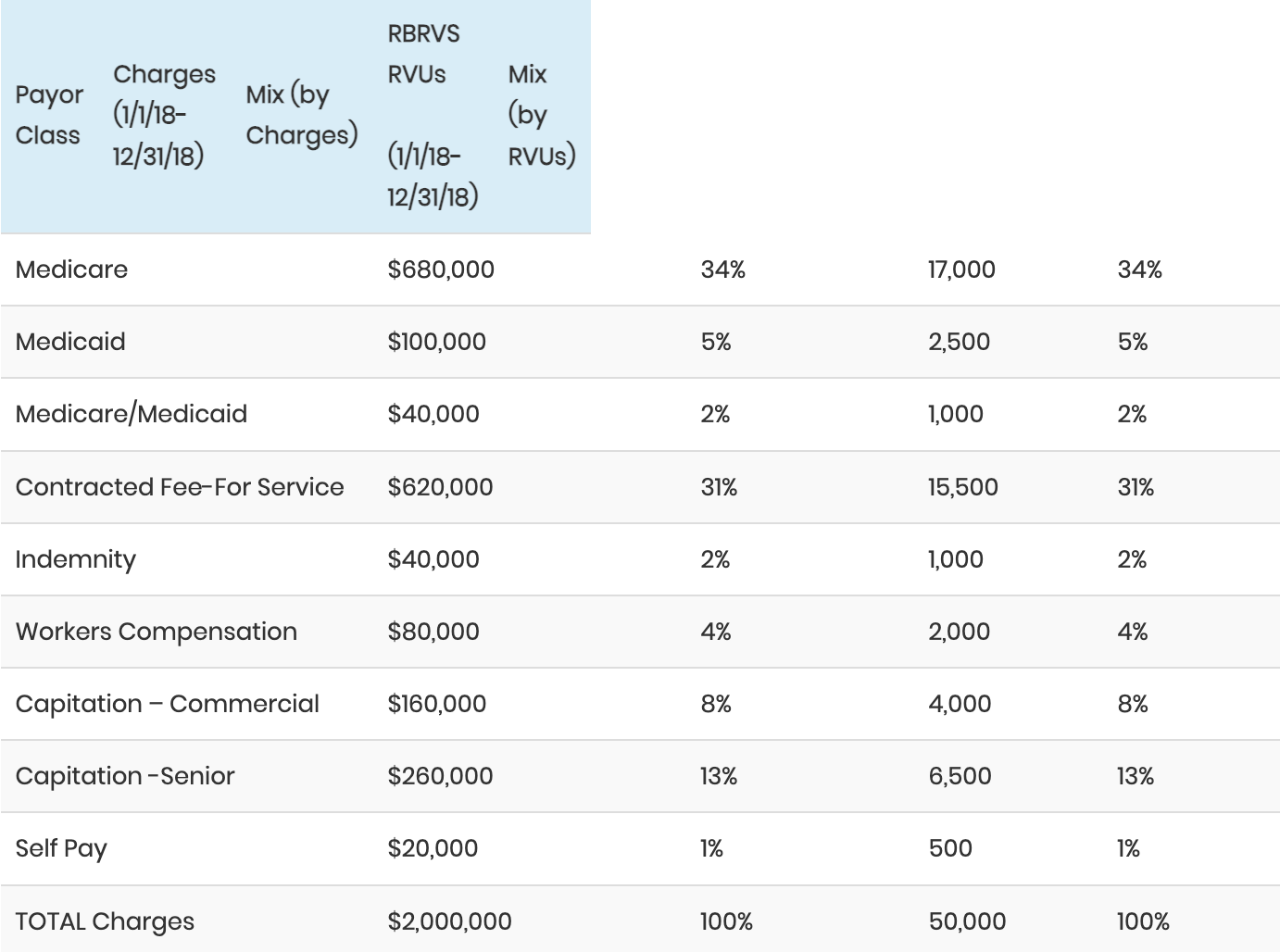Q2 2019 Newsletter
Client Spotlight: Pacific Eye Specialists
This month PMRG is proud to introduce you to one of our clients, Pacific Eye Specialists (PES). The following story from Dr. Bernd Kutzscher is about the program PES helped start in rural Guatemala 25 years ago.
Guatemala is a country in Central America that is blessed by great natural beauty and ancient culture, but also cursed by long-standing political violence and poverty. The majority of the approximately 17 million Guatemalan citizens live in or near the capital, Guatemala City. As one leaves Guatemala City and drives to the west and north toward Chiapas, Mexico, there is a dramatic change in the lifestyle of the Guatemalan people. The average person is much poorer and is still tied to an agrarian economy. The people are typically devout and humble. As one drives up into the higher altitudes, there are enormous volcanoes towering over dense jungle, dotted with small villages. In this area, there is still a significant Mayan population, despite the near genocidal violence toward the Mayans over the last decades.
When I first volunteered in 1990 at the Hospital de la Familia in the village of Nuevo Progreso, there was an active civil war in progress. The military government was systematically attacking the rural poor and the Mayans. As our medical team drove by bus from the capital to the area of the volcanoes, nearly every bridge had been blown up by rebels.
The government warned us that we could not count on protection from these guerillas. And yet, over the next weeks of concentrating on medical work and not politics, it became clear to us that the political picture was not what it seemed. We had many patients who told us that we were safe because the rebels had declared a cease fire to mark our stay. It became obvious that many of the people we were caring for were related to the rebels.
In any underdeveloped setting, one of the first challenges in delivering medical care is to gain the trust of the people and to let word-of-mouth build the program. My area of expertise, along with several other eye surgeons, was to cure blindness. But in this setting, becoming blind was a fact of life, like losing strength when becoming aged. It was not intuitively obvious to our Hispanic or Mayan patients that blindness could be cured. When we told them that this was true, they would often smile as if to say “another gringo untruth.” In the case of the Mayans who still speak a native language, we often could not communicate with them. But slowly we made progress. Patients would be lined up for a post-op exam the day after their surgery and just before their return to their homes – often a 20 mile or longer walk. They would exchange news and impressions of their surgery. As they celebrated seeing again, they enthusiastically told their friends and family that these American doctors seemed to know what they were doing.
Over the next 25 years, I have been privileged to return to Nuevo Progreso and to the Hospital de la Familia many times. Now the reputation of the medical teams is well established. The knowledge and technology that is expected in the U.S. is allowing us to perform increasingly sophisticated and successful eye surgery. But at the same time, the many troubles of the capital are starting to encroach on the rural areas. Guatemala has become the home to drug producers and drug camps – fueled by the demand for drugs in the U.S. And yet, there is still a heart-warming undercurrent of kindness in the rural people. When I was most recently at the Hospital de la Familia, a patient who was poor had cataract surgery without having to pay. On the day after surgery, he brought a bunch of bananas to me as a thank you. It reminded me that when I had first visited the village of Nuevo Progreso, I had been given a chicken and a pineapple.
To learn more about Hospital de la Familia and support medical aid in Nuevo Progreso, click here.
-
In today’s world of the practice of medicine, the payment for most medical/surgical care is provided by third-parties (insurance). Your Ophthalmology practice’s customers (patients) can be categorized by the insurance that pays for their care. This categorization, or Payor-Mix, is useful for making effective practice development (marketing) and management decisions.
-
Insurance classes should group insurance carriers and plans by expectation of payment. For example, the contracted, fee-for-service managed care plans, which have relatively similar payment levels, can form one group, and the expected percentage of the charges that can be collected from that group can be defined. This allows you to accurately budget your practice expenses and to predict collected revenue.
-
If you generate your charges, payments, and accounts receivable summary by payor class, you can identify patterns of growing receivables. If a carrier has increasing receivables over 90 days, you can look at that carrier and individual plan to determine which plan or plans are paying slowly.
-
A report of your charges by payor-class tells you to whom you are providing your services – who your customers are. This information is invaluable for the strategic management of your practice, including analysis of potential managed care opportunities, growing practice volume, the introduction of new services, adding an additional office location, and the addition of new providers.
-
There are three criteria for defining a payor class:
First, there is the expectation of payment (payment level);
Second, there are unique payment and/or collection characteristics that a particular set of insurance plans may have that can facilitate accurate billing and/or collections (e.g., are balances billed to patients);
Third, there may be an individual insurance plan that receives a critical percentage of your charges (5% to 10% or more) that justifies a class of its own (e.g., Blue Shield).
A typical set of categories might be:
Medicare (set allowable payment schedule)
Medicaid (set allowable payment schedule)
Medicare/Medicaid (expect approximately 80% of the Medicare Fee Schedule – Medicare Fee Schedule minus co-payments)
Contracted, discounted fee-for-service managed care (agreement to accept contracted amount as payment-in-full; most plans in a market allow payments within a relatively narrow range)
Capitation (no fee-for-service payments)
Workers Compensation (allowable payment schedule)
Indemnity Insurance (insurance pays, patient responsible for balance, expectation of receipt of 100% of charges)
Refractive/cosmetic
Self-Pay (uninsured, medically indigent, and other)
Assigning Insurance Plans into Payor-Classes
The process of assigning insurance plans into payor-classes is relatively straightforward. Most practice management/billing computer systems have an “insurance set-up” function that is usually a screen that allows the user to assign characteristics to each insurance plan.
Each contract written by an insurer has its own characteristics. For instance, Acme Insurance Company may have Acme Choice PPO as well as the Acme Choice PPO contract with Ace Machine Tool with a $10 co-payment. Or, there may be a contract with Zero Hardware requiring $5 co-payments which also includes refractive surgery. It is obvious that the insurance for the employees of these two employers, although both Acme Choice PPO, must be entered into the computer as separate plans even though they are in the same class.
It makes no difference if the plan is a PPO or an HMO, as long as the payment expectations are similar.
Avoid these Common Pitfalls
Do not mix different types of plans offered by the same insurance company into the same class. For example, Acme Insurance Company may offer another set of products that are indemnity plans. That is, these plans pay all or part of the physician’s bill, and the patient is responsible for the balance. The expectation of payment is 100% of the charge, so these plans should not be mixed into the same class as the contracted fee-for-service plans.
Do not place a PPO plan in which your practice does not participate into the fee-for-service managed care class. Remember, if you do not have a contract with a particular plan, the patient is responsible for the balance of your bill after the insurer pays, making that insurance plan indistinguishable from indemnity plans.
Finally, make sure that all your charges are submitted at your standard fee schedule. Do not attempt to charge at new (the allowed amount for that CPT code and the carrier to which the claim is being submitted). For self-pay patients, always charge your standard fee. You can accept less than your fee, but the charges should be standardized.
Reporting and Analyzing
There are two basic methods for reporting and analyzing your payor-mix: Charges by payor-class and RBRVS RVUs provided by payor class. Of course, if your fee schedule was developed using RBRVS and a conversion factor or as a multiple of the Medicare Fee Schedule, the payor-mix will be identical using either methodology.
The following is an illustration of a payor-mix analysis using gross charges:
Note that there are two capitation classes, one for senior patients and one for commercial. Even though there is no direct, fee-for-service income for the services, or charges for those patients, it is important to separate these patients into two separate classes for analysis purposes.
Another aspect of using gross charges or RVUs to define payor-mix is the effect of multiple procedures and/or surgical assists. While this is not a major problem in General Ophthalmology, it must still be considered.
Secondary procedures, while generally charged at 100% of the practice’s fee, are paid at 50% or less of the allowable payment schedule. For accurate payor-mix assessment, those procedures modified with a –51 (multiple procedure), –80 or –81 (surgical assist), or -26 (professional) and -TC (technical component) should have the corresponding charges and/or RVUs reduced for the purpose of this calculation, and not for billing. They should be charged to the insurer at full fee.
The Table above was derived from a practice that used RBRVS at $40 per unit to generate its fee schedule, which explains the identical payor-mix using both gross charges and RVUs.
Meet the Biller: Mikaela Montes-Szekely
Mikaela joined the PRMG team in October of 2010. She is a graduate of Everest College with a certification in Medical Billing. She began her medical billing career with PRMG as an intern and worked her way up through the ranks to her current position as a team leader.
Mikaela handles a number of our accounts and manages a team which works with clients on the Advancedmd software platform. She enjoys working closely with clients and making sure their accounts are well handled.
Mikaela and her husband, Nick, are still celebrating the birth of their beautiful son, Noah. Noah was born on May 5th at 5:48 am and was 9 lbs 1 oz and 22 inches long. Noah joined their house with their three cats and is enjoying tons of love from their family and friends.
Mikaela is a Cubs fan and enjoys spending time with her family. She has been very active in helping raise awareness and funds for Pediatric Cancer research after a close family friend lost a young daughter to cancer.
We are extremely glad that Mikaela is a member of the PMRG team!









